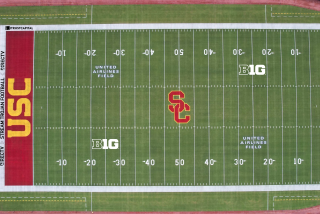Cash-Strapped Schools Cultivate Marketing Deals
- Share via
In California’s Scotts Valley, the school district faces the prospect of slashing $900,000 from a $15-million budget next year. So the district hired a marketing firm to find companies willing to sponsor a new swim center or theater at the local high school.
In return, says school board member Allison Niday, companies will get plaques or mentions in school newspapers.
Similar deals are being made nationwide at all levels of education as money-strapped schools increasingly turn to companies for financial support.
“First and foremost, our schools are struggling,” said Dan Fuller of the National School Boards Assn. “Many districts are engaged in this [commercialism] because of the dire straits they’re in. This presents a real opportunity and a trend that will continue and possibly grow.”
As a result, corporate advertisements are cropping up on everything from high school scoreboards to the sides of school buses.
And soft drinks are being sold under contract in many schools.
In Seattle, the school district -- its budget so tight that nearly 200 staffers were cut -- has renewed a deal with Coca-Cola Co. for vending machines in middle and high schools. The five-year contract, worth more than $1.5 million, helps fund field trips, yearbooks, school newspapers and extracurricular activities.
Colleges and universities -- even New York City itself -- have signed on with corporations.
The University of Vermont is getting $4.3 million over 10 years from Coca-Cola in exchange for giving the firm the right to provide all soft drinks, bottled water, packaged juices and sports drinks sold in vending machines and campus dining rooms.
Just a few months ago, the makers of Snapple won exclusive rights to sell their bottled water and fruit juices in vending machines on all city property in New York, including schools. Snapple will pay the city $106 million and spend $60 million more to market and promote the city over the five-year contract.
Critics say such deals erode the schools’ long-held ability to insulate children from marketing and promote a climate where children are asked to pay for education one soda at a time. And the sale of soft drinks in school, they argue, may add to the roughly 15% of children that the Centers for Disease Control and Prevention calls overweight.
“It’s really a bargain with the devil because what these districts essentially are doing is selling their students’ health,” said Alex Molnar, head of Arizona State University’s Commercialism in Education Research Unit, which studies corporate involvement in schools.
Niday, the mother of fourth- and eighth-graders, said “going to corporate sponsorship is a little sad.” But she insists that her 2,700-student district has few other options after the community already rallied to raise $400,000 to mitigate additional cuts this school year, sparing some library aides, program supervisors and counselors.
The district so far has partnered with a construction company that will provide $14,000 and improvements at Scotts Valley’s middle school, and a roofing firm that will give $5,000 and gardening boxes to several schools.
“The state funding process is broken, and to sit back and wait for it to be fixed is to do nothing for our children,” Niday said. “We have to look at different mechanisms for our funding,”
During the 1990s, the number of exclusive corporation-school marketing deals jumped 13-fold while the number of sponsored educational materials supplied by big business or trade groups grew 18-fold, according to a 2000 study by Molnar’s group.
Meanwhile, the General Accounting Office in 2000 reported that just 19 states then had laws and regulations governing commercial activities in public schools. The school boards group, representing about 15,000 boards nationwide, believes that lawmakers shouldn’t meddle in what should be a local issue, Fuller said. That feeling was echoed by the National Soft Drink Assn.’s Sean McBride, who said “local schools and parents decide what kind of food policy they have for each school.”
The deals can be lucrative. Coca-Cola has contracts with at least 6,000 of the nation’s more than 14,000 public school districts. Almost 99% of high schools, nearly 75% of middle schools and 43% of elementary schools have vending machines or snack shops, the CDC says.
To Molnar, school districts chasing commercialism deals “have sort of lost themselves in a race to the bottom. Until the state and a school district erects a clear barrier and draws a bright line, the bad practices are going to drive out the good.”
But in Scotts Valley, florist Dennis Perry, father of a third-grader, says savvy children have already been exposed to marketing “anyplace and everyplace. As long as the upper hand is given to schools to dictate where the money’s going and what’s being advertised, I don’t think it’s a problem. You either embrace it and make it work in your favor or it passes you up.”
More to Read
Sign up for Essential California
The most important California stories and recommendations in your inbox every morning.
You may occasionally receive promotional content from the Los Angeles Times.













